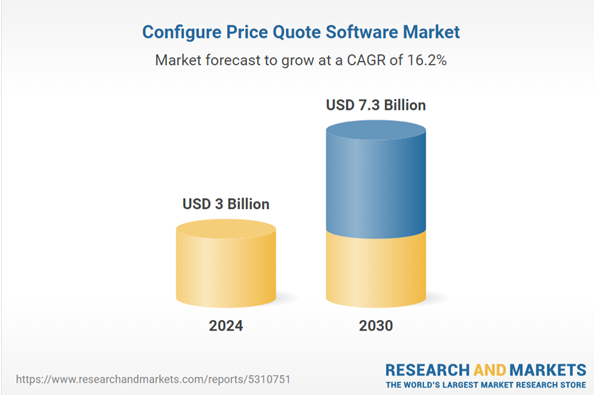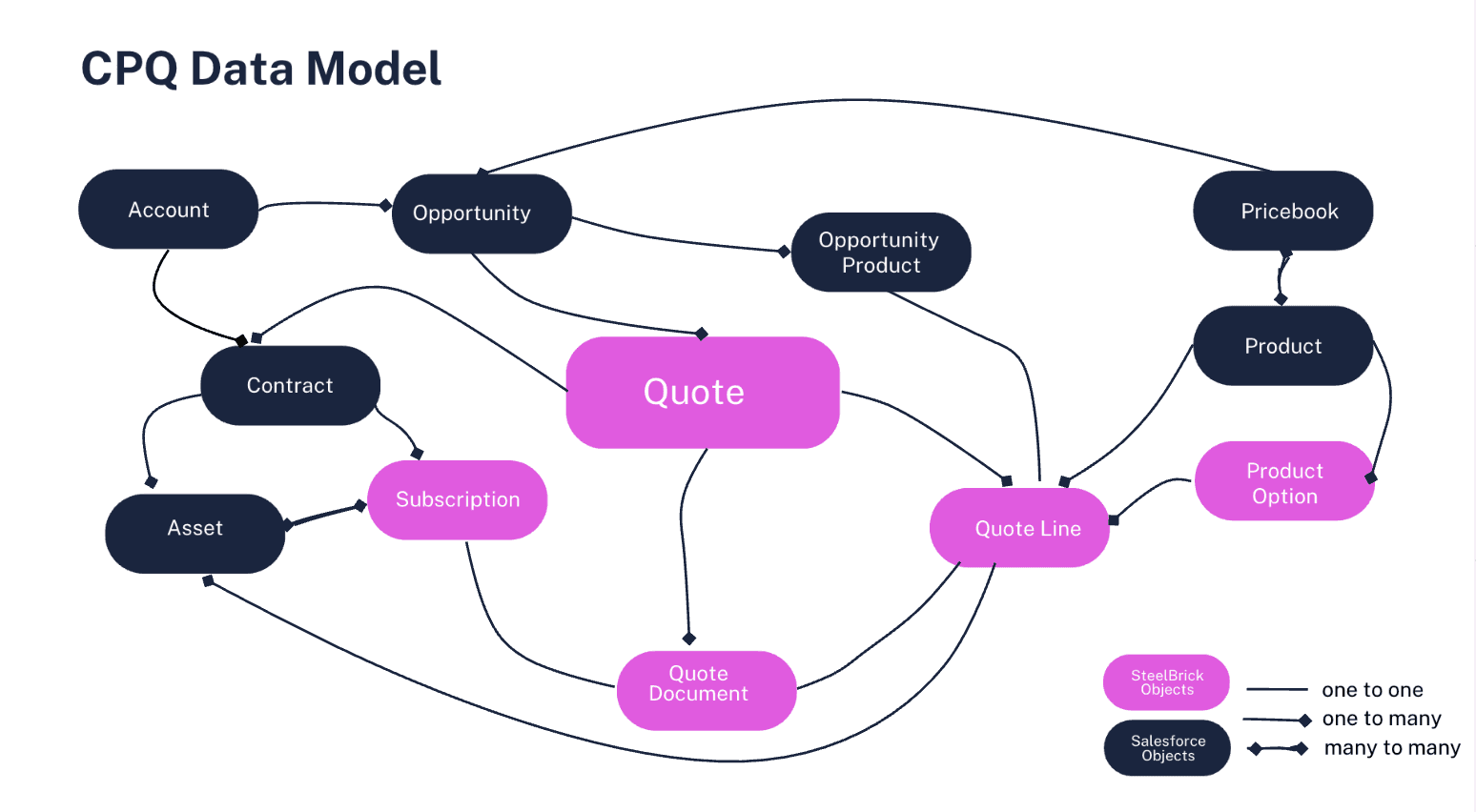The Configure Price Quote (CPQ) data model explains how the CPQ process connects products, pricing, and rules to create accurate quotes. It defines product catalogs, price books, configuration rules, and quote line items, keeping sales teams consistent across markets.
Looking to optimize your Salesforce CPQ implementation? Contact Think Beyond to discuss your project.
More and more businesses turn to adopt CPQ to speed up quoting and reduce costly errors in sales cycles. According to Research and Markets, the global CPQ software market was valued at $3.0 billion in 2024, with projections to reach $7.3 billion by 2030 at a CAGR of 16.2%.

In this guide, you’ll learn what the CPQ data model is and how its components work.

What is the CPQ data model?
The CPQ data model is the structural framework that defines how Configure, Price, Quote (CPQ) systems organize and manage data. It describes how products, pricing logic, and rules interact to generate consistent and accurate quotes. The model connects different objects such as products, price books, configuration rules, and quote line items, creating a reliable foundation for quoting processes.
The acronym “CPQ” stands for Configure, Price, and Quote, where each part stands for a distinct function of the model:
- Configure – Represents how product attributes, options, and bundles are structured and validated through configuration rules.
- Price – Covers list prices, price books, discount schedules, and formulas used to calculate customer-specific pricing.
- Quote – Includes quote records and related line items, which store selected products, applied discounts, and totals for customer proposals.

What are the core components of the CPQ data model?
The core components of the CPQ data model are products, prices, rules, and quotes, which work together to generate accurate proposals. Each component manages a specific type of information and connects through defined relationships with standard Salesforce objects such as Account, Quote, and Opportunity. These linked objects create a framework where what you sell, how you price it, the rules that apply, and the resulting quotes are consistently managed across the sales cycle.
To understand how these elements function in practice, it helps to break the CPQ data model into its core building blocks. Each component has a distinct role but remains tightly connected to the others, forming the backbone of quoting and pricing operations. Below, we’ll look at the main components in detail, starting with the product catalog.
1. Product catalog (products, bundles, attributes)
The CPQ product catalog is the foundation of the CPQ data model. It defines all items that a business can sell, from standalone products to complex bundles. Each product record typically contains attributes such as SKU, description, and availability.
Bundles group multiple products into a single package, often with mandatory or optional options. Attributes describe product features like size, color, or capacity and can drive configuration and pricing logic.
Key elements of the product catalog include:
- Products – Individual goods or services available for quoting.
- Bundles – Parent products linked to related options or accessories.
- Attributes – Data points that describe product characteristics and affect configuration or pricing.
2. Price books and price entries
Price books and price entries define how the CPQ system manages product pricing. A price book is a collection of product prices, often segmented by market, region, or customer group.
Each record in a price book links to a specific product through a price entry, which contains the list price, currency, and effective dates. The date field in a price entry is key for tracking when prices are effective, guaranteeing that quotes correspond with the correct pricing at any given time. In simple words, the price book tells the system which price applies in a given context. Businesses often maintain multiple price books to handle retail, enterprise, or partner pricing.
Key elements of price books include:
- Price Book – Repository of product prices for a specific market or channel.
- Price Entry – Record linking a product to its price, currency, and effective date.
- Multiple Price Books – Support for differentiated pricing strategies across regions or customer tiers.
Tip: keep price books and pricing data up to date to guarantee accurate and reliable quoting within Salesforce CPQ.
3. Quotes and quote line items
Quotes and quote line items represent the actual customer-facing proposal generated in CPQ. A quote acts as the header record, storing customer details, validity dates, and total amounts.
Quote line items break down the quote into individual products with quantities, discounts, and net prices. We can say that the quote is the offer, while quote line items are the detailed components of that offer. Line items also support bundles, with parent lines for main products and child lines for included options.
Key elements of quotes include:
- Quote – Main record containing customer, terms, and total pricing.
- Quote Line Item – Detailed record for each product, including quantity, list price, and discounts.
- Bundle Hierarchies – Structure that links parent products with related options in the quote.
4. Configuration rules
Configuration rules control how products can be combined and sold in the CPQ data model. They prevent invalid product combinations, recommend add-ons, or require specific options when certain items are selected. These rules operate directly on the product catalog, guiding sales teams toward valid configurations.
Moreover, configuration attributes are often linked to features through a lookup relationship, which helps set connections between different objects in Salesforce CPQ for more complex configuration and pricing rules. In such cases, businesses can customize configuration rules to fit their specific requirements, using resources like the implementation guide or expert assistance to facilitate these customizations.
For example, a rule may block incompatible hardware components or automatically include a mandatory service plan. When rule conditions are met, certain actions are triggered, such as dynamically adjusting pricing or product selections. Without these controls, quotes risk containing errors that affect fulfillment.
Key elements of configuration rules include:
Compatibility Rules – Restrictions that block invalid product combinations.
Dependency Rules – Conditions that require specific products or options.
Recommendation Rules – Automated suggestions for cross-sell and upsell items.
Validation Rules – Checks that highlight missing or incorrect selections.
5. Pricing rules and adjustments
Pricing rules define how the system modifies base prices from the price book. They apply discounts, markups, or special calculations based on conditions such as customer type, contract, or purchase volume. The CPQ data model links these rules to products or quote line items, allowing flexible pricing strategies.
What’s more, pricing rules can be run automatically based on certain triggers, so that the correct adjustments are applied in real time. Managing different versions of pricing rules is key for continuous improvement and smooth upgrades, as it allows your business to test and deploy changes without disrupting existing processes.
For instance, a pricing rule may grant a volume discount after a threshold or override the price for a negotiated contract. This layer of logic allows organizations to manage both standard and dynamic pricing structures.
Key elements of pricing rules include:
- Volume Discounts – Adjustments triggered by quantity tiers.
- Contracted Prices – Customer-specific overrides stored in the system.
- Promotional Discounts – Time-limited reductions or offers.
- Formulas and Markups – Calculations that modify list prices based on costs or attributes.
Benefits of a well-designed CPQ data model
A strong CPQ data model improves quoting speed, accuracy, and consistency. It also supports growth as businesses expand product catalogs and enter new markets. Sales, finance, and operations all benefit when the structure is clear and standardized.
For ongoing optimization, companies often rely on a Salesforce managed service provider.
Expert insight
„In Salesforce CPQ projects, we often see that a well-structured data model is the foundation of long-term success. Without clearly defined product catalogs, rules, and price books, even the most advanced automation won’t deliver consistent results.”
– Marcin Pieńkowski, Head of Salesforce at ThinkBeyond
Main benefits include:
- Faster quoting with predefined product and pricing data
- Fewer errors through rules that block invalid configurations
- Consistent pricing across regions, contracts, and customer segments
- Easier integration with CRM and ERP systems
- Simpler updates when adding new products or bundles
- Reliable data for compliance and reporting
In practice, this means sales teams can generate valid quotes quickly, while back-office systems receive clean data for order processing. There are various solutions available to help businesses optimize their CPQ data model.
A strong CPQ data model is not only theoretical – it directly impacts how companies scale quoting processes. For example, Virtana’s case study shows how Salesforce CPQ replaced manual Excel-based operations with an automated data model. By introducing product bundles, complex pricing rules, and guided configuration, Virtana reduced errors, accelerated response times, and gained the flexibility to negotiate with customers more effectively. This demonstrates how a well-structured data model translates into tangible business outcomes.
How major CPQ platforms structure the data model
Different CPQ platforms use similar concepts but organize their data models in specific ways. Each system defines how products, prices, rules, and quotes interact. We can say the goal is the same — accurate and scalable quoting — but the technical setup varies.
Expert insight
„Enterprises rarely rely on a single system, CPQ must integrate with CRM, ERP, and billing. A flexible data model is what makes those integrations scalable and future-proof.”
– Adam Czeczuk, Head of Consulting at ThinkBeyond
We can define 3 major CPQ platforms:
- Salesforce CPQ connects products, price books, quotes, and quote lines through native CRM objects and CPQ extensions. Its object model also adds elements like Configuration Attribute, Configuration Attribute Value, and Bundle for managing complex product setups.
- Oracle CPQ uses a standalone structure with parts, models, and line hierarchies managed through a commerce engine
- SAP CPQ organizes data around products, markets, and price books with direct links to ERP and S/4HANA systems
For a clearer picture, the table below compares how leading platforms implement core elements:
The way CPQ platforms structure their data models determines how effectively they can support complex business needs. In Virtana’s case, Salesforce CPQ allowed the company to unify processes on a single platform and manage bundles, discounts, and configuration rules at scale. According to the Virtana CPQ transformation case study, moving to Salesforce CPQ gave decision-makers real-time control over KPIs such as quote-to-close ratio and sales velocity insights that were impossible to achieve with fragmented spreadsheets. This highlights why organizations choose Salesforce CPQ over manual or less integrated solutions.
Conclusion
The CPQ data model defines how products, prices, rules, and quotes connect to produce consistent and accurate offers.
Such structure supports faster quoting, cleaner integration with CRM and ERP platforms, and easier maintenance as product catalogs expand. Salesforce, Oracle, and SAP implement the same principles differently, but each relies on the same core entities: product catalog, price books, rules, and quote records.
Remember to pay attention to these elements, as it will reduce errors and improve scalability across the quote-to-cash process.
Looking to optimize your Salesforce CPQ implementation? Contact Think Beyond to discuss your project.
Frequently Asked Questions (FAQs)
1. What is a CPQ data model?
A CPQ data model is the structured framework that defines how a Configure, Price, Quote system stores and links data. It organizes products, price books, configuration rules, and quote records into a relational model. The purpose is to generate consistent and accurate sales quotes. Most CPQ data models include product catalogs, price entries, discounts, configuration constraints, and quote line items. This structure allows the system to automate quoting and integrate with CRM or ERP platforms.
2. What are the core components of the CPQ data model?
The core components include: products, price books, quotes, quote line items, configuration rules, and pricing rules. Products define what is being sold, while price books store list prices and market variations. Quotes and quote lines capture customer offers, quantities, and totals. While Configuration rules control valid product combinations, and pricing rules apply discounts or adjustments. Together these entities create the backbone of a CPQ system.
3. How does the CPQ data model work in Salesforce CPQ?
Salesforce CPQ extends the standard Salesforce object model with CPQ-specific objects. It uses Product, Price Book, Quote, and Quote Line objects as core entities. Additional objects include Configuration Attribute, Configuration Attribute Value, and Bundle. These support product options, guided selling, and complex pricing logic. Salesforce CPQ’s model integrates directly with opportunities, accounts, and orders inside the CRM platform.


